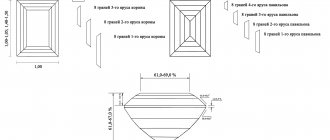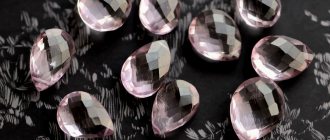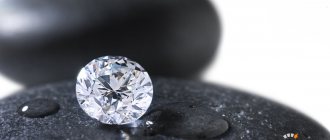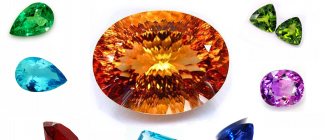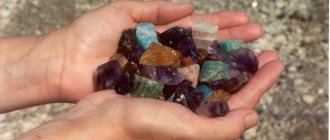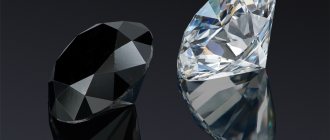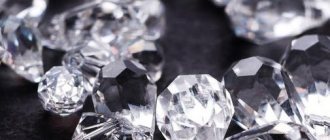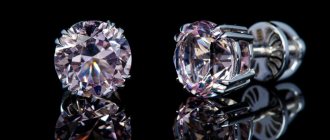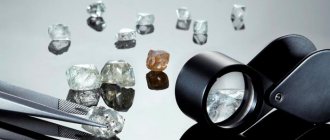Cut is one of the most important quality characteristics of a diamond. Therefore, it is very important to know what types it is classified into in order to make the best choice when purchasing a diamond. Let's take a look at what types of diamond cuts there are and what their characteristics are.
People often use the words "cut" and "shape" interchangeably when talking about diamonds. However, the meanings of these two terms are slightly different from each other. The term "shape" refers to the overall characteristic of the stone.
On the other hand, a certain cut implies a certain shape. The term "cut" technically refers to the extreme numbers, arrangements, shapes and proportions of a stone's facets.
So the shape of a diamond tells you what the stone looks like, and its cut gives you information about how that shape was achieved through processing.
Technically, two diamonds can have the same or similar shapes, but their cuts will be considered different if their facets are arranged or shaped differently.
What is commercial cutting?
To answer the question of what a commercial cut is and how it differs from an ideal diamond cut, you need to imagine how a diamond is turned into a diamond. Let's look at an example.
The figure shows that several diamonds of different sizes and weights can be cut from the same part of a diamond: 1 carat with an ideal “A” cut, 1.11 carats with a “B” cut and 1.21 carats with a “B” cut. For commercial cutting, the least loss of rough diamonds and the production of a diamond of greater weight and size are more important than the production of a diamond with a lower weight but a perfect cut quality. It will depend on the characteristics of the diamond whether the diamond will be “stretched” in height or diameter, or whether not all parts of the diamond will have incorrect proportions.
What do the characteristics of a diamond mean?
Since Soviet times, the Russian jewelry trading system has introduced a system that should fully disclose the characteristics of the diamond in the product. Knowing the four characteristics of a diamond - cut, color, clarity and weight - will allow you to select a diamond with the skill of a jeweler.
Let's try to decipher the designation 2BrKr57 - 0.2ct - 3/5A
It looks like this:
“ 2Br ” means the number of stones in the product, in this case there are two of them and these are diamonds.
“Kr57” shows the type of stone cut: “Kr57” - Round 57 faces, “Kr17” - Round 17 faces, “Kr33” - Round 33 faces. There are not only round diamonds, but also other shapes: “M-55” - marquise cut, elongated stone, somewhat reminiscent of a boat “G-56” - pear-shaped “I-57” - “emerald” cut, elongated, rectangular shape “P-65” - “Princess” square stone with 65 facets
And many others.
0.2 ct – total carat of identical stones. If the stones in the product are of different sizes or purity, then each stone is assigned its own carat value.
A carat is a unit of measurement for the mass of a diamond and other precious stones. 1 carat = 200 milligrams = 0.200 grams. Large diamonds are much rarer than small diamonds, so large diamonds are much more valuable. Thus, a 2-carat diamond costs more than two one-carat diamonds with the same characteristics. In fact, the value of a diamond tends to increase dramatically as the weight of the diamond increases.
«3/5“—these numbers mean the quality characteristics of the stone. The color is written first, the purity of the stone second.
Color
Diamonds come in a variety of colors, but the clearer a diamond is on the standard scale, the more expensive it is. In reality, there are no completely colorless diamonds; the term “colorless” describes diamonds that are on the normal color scale.
For the cheat sheet:
Diamonds with a color rating of 1 to 4 can be called “completely colorless” and have a slight hint of icy white color.
From 5 to 7 - we can say that they are “colorless”, with a slight pearly or smoky tint, visible only in comparison to being completely colorless.
Color 8 has a light sunny yellow tint.
Color 9 is close to coffee color.
It should be noted that there are also fancy shades of diamonds: pink, blue, turquoise.
Purity
Diamonds without visible defects (scratches, marks, minerals and other small characteristics that reduce the quality of the diamond) are more valuable. However, most inclusions are not visible without 10x magnification. Clarity grading is based on the location, size, type and number of flaws found in the diamond.
Diamond Clarity Rating:
Diamonds with a clarity rating of 1 to 4 can be described as “crystal clear,” with no more than three inconspicuous natural inclusions permitted, recognizable only by an experienced gemologist using a microscope with 45x magnification.
Clarity 5-6 is an almost transparent diamond, which allows for subtle natural inclusions that can only be recognized by a specialist using a sophisticated optical instrument with 10x magnification.
Clarity 7 is a Clear diamond that allows for subtle natural inclusions or subtle changes in structure or unnoticeable graphite inclusions that are only visible under a sophisticated optical instrument with 10x magnification.
"A" - Cut
The cut of a diamond has the greatest effect on a diamond's sparkle and brilliance. Most gemologists believe that the cut of a diamond is one of its most important characteristics. Width and depth have a significant effect on how light passes into the diamond and is reflected as sparkle. An ideally good cut reflects light from the top of the stone, bringing out the play of light. If the cut is superficial, then the light is scattered to the sides and the diamond loses its sparkle. If the cut is too deep, the light disappears at the bottom and the diamond appears dark and dull. The “A” cut is considered the most ideal.
Diamonds with poor symmetry
| A round, oval-shaped diamond with a “butterfly” visual effect. This effect can often be found in fancy-cut diamonds in the shape of an oval and a drop (pear). | A 1 carat diamond with a diameter of 6.7 mm is stretched in diameter and has asymmetrical facets. An ideal cut diamond with this diameter should weigh 1.12 carats. |
| Height/Diameter,% | Area/Diameter,% | Diamond Cut Grading |
Move the sliders to visually see the impact of proportions on how a diamond interacts with light.
Brilliant cut and mixed styles.
Brilliant cuts have facets designed to maximize the brilliance of the stone. The classic round cut is brilliant cut.
Step cuts, on the other hand, have facets that are parallel to each other and located at the edge of the stone; they do not increase the brilliance or sparkle of the diamond. An example of a step cut is emerald.
Mixed cuts have both brilliant and stepped details. For example, “Radiant” is a type of mixed cut.
"Fancy" cuts.
A fancy cut is any diamond cut that differs from the classic round cut. For example, pear, heart and oval are unusual diamond cuts.
Cutting grade.
There are different ways to certify a diamond cut, but in general, a cut is graded based on how close its proportions are to generally accepted ones.
Round cut grading is the most common standard for certification, and the guidelines for its proportions are quite detailed. Standards for certification of other cuts are not as detailed and are usually less stringent.
Marquis
Marquise is the longest form of cut, a combination of length and width of 2 to 1. This allows you to visually enlarge the stone compared to other cuts of the same weight. The history of the appearance of the first marquis takes us to the 18th century to the court of the French king Louis XV. He commissioned the court jeweler to create a diamond shaped to resemble the smile of his mistress Madame Pompadour. It is worth noting that such stones look great in rings, standing out effectively against the background of the classic round shape.
Photo: personal archive of the author // Sergey Izmestyev
Emerald and Asher
Unlike the above forms, which are cut mainly with a brilliant cut, the emerald and asscher forms are cut with a step cut. Large rectangular edges, large flashes of color appearing on them - all this gives a charming effect to such stones. Another feature of the step cut is that it is very open, all inclusions are clearly visible, so it is recommended to buy this cut with a clarity below VS1. Look great in rings and earrings.
Photo: personal archive of the author // Dmitry Stolyarevich
Impact on cost.
One of the factors that determines diamond prices is the amount of labor required to create a salable stone.
Not surprisingly, cutting fewer facets requires less work, which is why single cut is cheaper than full cut.
As mentioned, smaller diamonds (such as those weighing around 1/10 of a full carat) are usually single cut. It really doesn't make sense to completely cut such diamonds, since the additional edges won't be visible anyway.
Not to mention, cutting 58 small facets on a tiny diamond is much more difficult to do than on a large one, and will make a small diamond unnecessarily expensive.
These diamonds are most often used as side diamonds (also called "accent stones") in bracelets, rings, pendants, earrings, etc.
You should not worry if you find that the small diamonds on a particular piece of jewelry are single cut stones. This is normal practice and will not detract from the appearance of the jewelry. Basically, when purchasing, you should prefer these tiny stones to be single cut if you want to save money.
Full cut diamonds as side diamonds will have no apparent value but will cost you extra dollars.
Next time you buy jewelry with side stones, carefully inspect and check their color and clarity; Additionally, use a magnifying glass to look for small chips or cracks.
If the stones have a good shine and are not too dark, then everything is fine.
Pillow and radiant
Cushion, or cushion, is the oldest cut; such stones began to be made in the 18th century. It can be either more square or elongated. The shape of the stone is similar to that of a pillow, hence the name.
Photo: personal archive of the author // Dmitry Stolyarevich
Radiant, unlike a cushion, has straight sides and corners cut at 45 degrees. Cushion and radiant are most often found when cutting colored diamonds, since they allow the cutter to “collect” and enhance the color of the stone as much as possible, which is especially important in colored diamonds. The cost of the stone itself directly depends on this.
Photo: personal archive of the author // Dmitry Stolyarevich
History of the cutting
They started cutting jewelry relatively recently. In ancient times, it was believed that in order to preserve the magical properties of a stone, it was necessary to preserve its original appearance. But the first attempts to give the mineral a beautiful shape were made in the 14th century in Europe. Jewelers have noticed that if the surfaces of the stone are leveled, they can get a brighter glow and better transparency.
Cutting a large diamond in a mechanical clamp
The first minerals were called sharp stones because they had pointed tops and were shaped like octahedrons. A processing close to the real one appeared in the 16th century and was called Table Stone, or Table Cat, that is, cutting with a platform. The method arose simultaneously with roughing and polishing of diamonds. Over time, this technique was modified and improved, and it was already believed that such treatment enhances not only the brightness of the stone’s glow, but also its magic. Most of the stones were recut. One of the first improvements in processing was the appearance of four additional edges of the bottom and top.
The shape of the cut also became more complex. Gradually the stone turned into a circle after processing. This method was called the “simple round cut” or “incomplete round cut”. And by the end of the 17th century, such cutting forms as pointed and platform were no longer used.
Rose cutting was also popular at one time, and the stones became widespread, especially in cities such as Antwerp and Amsterdam. The popularity of the technique reached its peak in the 15th century. And in the 19th century, a method called the double rose even appeared. The Florence and Sancy diamonds were cut using this method. The shape was interesting, so the cutting continued to improve and the number of facets increased.
An interesting cutting method was the Mazarin method. This technique had an increased number of edges, which made processing more difficult. Only the rich could afford such diamonds, and the work was done by professional, experienced jewelers. Using such cuts, craftsmen better understood what was needed for the ideal play of light and moved closer to today's classical method of processing.
Interest in cutting and working with diamonds waxed and waned. But after the discovery of Brazilian deposits, another Brazilian processing technique appeared. Jewelers recut existing diamonds several times to follow fashion trends, until modern cutting techniques appeared in the mid-19th century. It also did not take root immediately due to large losses of raw materials during the process and the small size of the processed stones. But it was this method that was able to fully reveal the beauty of diamonds.
How to distinguish a real diamond from a fake?
Due to the fact that diamonds are of particular value and have always been expensive, there are a large number of fakes on the market. Therefore, do not even try to delve into the specifics of the definition of a stone. It is simply impossible to identify a diamond by “eye” or “tooth”. When purchasing an unmounted diamond, the seller must issue a certificate of conformity and authenticity of the diamond for each stone, confirmed by an independent authoritative laboratory, which will indicate its number, parameters and proportions, as well as reliably provide information about the symmetry and quality of polishing of this stone. An unmounted diamond must be packed in a blister, where the number of the certificate of conformity is indicated, and it is opened directly by the buyer.
The most valuable and authoritative confirmation of the quality of a diamond is the GIA certificate. This is a kind of passport for the stone, which confirms its authenticity.
GIA Certificate
Another win-win option for buying a real diamond is a simple rule: choose a reliable seller. There are many large companies that have been selling both loose diamonds and diamond jewelry for many years. Choose reliable sellers who sell diamonds without settings or jewelry with diamonds, and then the quality of the stones will not raise any doubts.
Understanding diamonds at a professional level is very difficult, but each of you will be able to master this topic enough to buy a diamond without a setting or jewelry with a high-quality gemstone and not be mistaken. And in this article, I explained in detail how to understand diamonds even if you are a beginner.
Is it possible to combine different types of stone cuts in one piece of jewelry?
Depending on the combination of stones of different cuts, you can achieve the desired effect and give the jewelry a certain character. For example, make the decoration more delicate or emphasize the importance of the central stone, visually enhance the color saturation of the stone, add severity and clarity to the lines, or, conversely, blur them.
1/2
Photo: personal archive of the author // Sergey Izmestyev
2/2
Photo: personal archive of the author // Sergey Izmestyev
